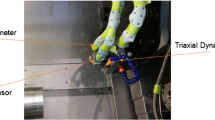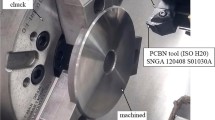Abstract
Cutting tools are one type of critical component of modern computer numerical control (CNC) machining systems. They wear out continuously during the machining process until they fail, and cutting tool failure can lead to the collapse of the entire system and even cause substantial losses. Therefore, it is of great importance to study the method for tool wear prediction. A new model for wear prediction of cutting tools is established based on a multi-stage Wiener process, where the degradation rates of cutting tools are considered to change in three stages based on the typical cutting tool wear curve model. Firstly, the degradation processes of cutting tools are divided into three stages. Secondly, the parameter estimation for each stage of the degradation processes of cutting tools is completed, respectively, by utilizing the EM (expectation–maximization) algorithm. Then, the wear of cutting tools is predicted, and the reliability of cutting tools is analyzed by using a numerical integration simulation method based on the Monte Carlo algorithm. Finally, the proposed model is illustrated and verified via the flank wear data of cutting tools, and the prediction accuracy is measured by mean squared error (MSE) and the coefficient of determination (\(R^{2}\)). The prediction results show that the proposed model enables us to make more economical maintenance by delaying the tool replacement time with fewer degradation data. Compared to the traditional methods based on machine learning (ML), the proposed model can complete the wear prediction and reliability analysis more accurately.











Similar content being viewed by others
Data availability
Not applicable.
Code availability
Not applicable.
References
Baur M, Albertelli P Monno M (2020) A review of prognostics and health management of machine tools. Int J Adv Manuf Tech 107(5–6):2843–2863. https://doi.org/10.1007/s00170-020-05202-3
Daigle MJ, Goebel K (2013) Model-based prognostics withconcurrent damage progression processes. IEEE T Syst Man Cy-s 43(3):535–546. https://doi.org/10.1109/TSMCA.2012.2207109
Ghosh N, Ravi YB, Patra A, Mukhopadhyay S, Paul S, Mohanty AR, Chattopadhyay AB (2007) Estimation of tool wear during CNC milling using neural network-based sensor fusion. Mech Syst Signal Pr 21(1):466–479. https://doi.org/10.1016/j.ymssp.2005.10.010
Zhang GQ, To S, Zhang SJ (2017) Evaluation for tool flank wear and its influences on surface roughness in ultra-precision raster fly cutting. Int J Mech Sci 118:125–134. https://doi.org/10.1016/j.ijmecsci.2016.09.013
Aboalkhair AM, Coolen FPA, MacPhee IM (2013) Nonparametric predictive reliability of series of voting systems. Eur J Oper Res 226(1):77–84. https://doi.org/10.1016/j.ejor.2012.11.001
Bousdekis A, Papageorgiou N, Magoutas B, Apostolou D, Mentzas G (2018) Enabling condition-based maintenance decisions with proactive event-driven computing. Comput Ind 100:173–183. https://doi.org/10.1016/j.compind.2018.04.019
Lei YG, Li NP, Guo L, Li NB, Tao Y, Lin J (2018) Machinery health prognostics: A systematic review from dataacquisition to RUL prediction. Mech Syst Signal Pr 104:799–834. https://doi.org/10.1016/j.ymssp.2017.11.016
Iliescu D, Gehin D, Gutierrez ME, Girot F (2010) Modelling and tool wear in drilling of CFRP. Int J Mach Tool Manu 50(2):204–213. https://doi.org/10.1016/j.ijmachtools.2009.10.004
Nouri M, Fussell BK, Ziniti BL, Linder E (2015) Real-time tool wear monitoring in milling using a cutting condition independent method. Int J Mach Tool Manu 89:1–13. https://doi.org/10.1016/j.ijmachtools.2014.10.011
An H, Wang G, Dong Y, Yang K, Sang LL (2019) Tool life prediction based on Gauss importance resampling particle filter. Int J Adv Manuf Tech 103(9–12):4627–4634. https://doi.org/10.1007/s00170-019-03934-5
Hu HJ, Huang WJ (2014) Tool life models of nano ceramic tool for turning hard steel based on FEM simulation and experiments. Ceram Int 40(7):8987–8996. https://doi.org/10.1016/j.ceramint.2014.01.095
Attanasio A, Faini F, Outeiro JC (2017) FEM simulation of tool wear in drilling. In: 16th CIRP Conference on Modelling of Machining Operations, Cluny, FR, 15–16, pp 440–444. https://doi.org/10.1016/j.procir.2017.03.249
Attanasio A, Ceretti E, Fiorentino A, Cappellini C, Giardini C (2010) Investigation and FEM-based simulation of tool wear in turning operations with uncoated carbide tools. Wear 269(5–6):344–350. https://doi.org/10.1016/j.wear.2010.04.013
Ye ZS, Chen N, Shen Y (2015) A new class of Wiener process models for degradation analysis. Reliab Eng Syst Safe 139:58–67. https://doi.org/10.1016/j.ress.2015.02.005
Li X, Ding Q, Sun JQ (2018) Remaining useful life estimation in prognostics using deep convolution neural networks. Reliab Eng Syst Safe 172:1–11. https://doi.org/10.1016/j.ress.2017.11.021
Wang JJ, Li YL, Zhao R, Gao RX (2020) Physics guided neural network for machining tool wear prediction. J Manuf Syst 57:298–310. https://doi.org/10.1016/j.jmsy.2020.09.005
Wu DZ, Jennings C, Tenpenny J, Gao RX, Kumara S (2017) A comparative study on machine learning algorithms for smart manufacturing: tool wear prediction using random forests. J Manuf Sci E-T Asme 139(7):071018. https://doi.org/10.1115/1.4036350
Li YX, Huang XZ, Ding PF, Zhao CY (2021) Wiener-based remaining useful life prediction of ro-lling bearings using improved Kalman filtering and adaptive modification. Measurement 182:109706. https://doi.org/10.1016/j.measurement.2021.109706
Freitas MA, de Toledo MLG, Colosimo EA, Pires MC (2009) Using degradation data to assess reliability: a case study on train wheel degradation. Qual Reliab Eng Int 25(5):607–629. https://doi.org/10.1002/qre.995
Ye ZS, Xie M (2015) Stochastic modelling and analysis of degradation for highly reliable products. Appl Stoch Model Bus 31(1):16–32. https://doi.org/10.1002/asmb.2092
Si XS, Wang WB, Hu CH, Zhou CMY, DH, (2013) A Wiener-process-based degradation model with a recursive filter algorithm for remaining useful life estimation. Mech Syst Signal Pr 35(1–2):219–237. https://doi.org/10.1016/j.ymssp.2012.08.016
Li B, Gao Z, Shen ZJ, Chen X, He Z (2013) A gamma Bayesian exponential model for comput-ing and updating residual life distribution of bearings. P I Mech Eng C-J Mec 227(11):2620–2633. https://doi.org/10.1177/0954406213475742
Pan DH, Liu JB, Cao JD (2016) Remaining useful life estimation using an inverse Gaussian degradation model. Neurocomputing 185:64–72. https://doi.org/10.1016/j.neucom.2015.12.041
Chen JC, Chen TL, Liu WJ, Cheng CC, Li MG (2021) Combining empirical mode decomposition and deep recurrent neural networks for predictive maintenance of lithium-ion battery. Adv Eng Inform 50:101405. https://doi.org/10.1016/j.aei.2021.101405
Liu WC, Yang WA, You YP (2022) Three-stage Wiener-process-based model for remaining useful life prediction of a cutting tool in high-speed milling. Sensors 22(13):4763. https://doi.org/10.3390/s22134763
Sun HB, Pan JL, Zhang JD, Gao DL (2020) Non-linear Wiener process-based cutting tool remaini-ng useful life prediction considering measurement variability. Int J Adv Manuf Technol 107:4493–4502. https://doi.org/10.1007/s00170-020-05264-3
Zhang YM, Wang H, Wan HP, Mao JX, Xu YC (2020) Anomaly detection of structural health monitoring data using the maximum likelihood estimation-based Bayesian dynamic linear model. Struct Health Monit 20(6):2936–2952. https://doi.org/10.1177/1475921720977020
Ding PF, Huang XZ, Zhang XW, Wang CL, Gao TH, Chang MX, Li YX (2022) Reliability updating and parameter inversion of micro-milling. Mech Syst SignaI PR 174:109105. https://doi.org/10.1016/j.ymssp.2022.109105
Karasalo M, Hu XM (2011) An optimization approach to adaptive Kalman filtering. Automatica 47(8):1785–1793. https://doi.org/10.1016/j.automatica.2011.04.004
Hu XL, Schon TB, Ljung L (2011) A general convergence result for particle filtering. IEEE T Signal Proces 59(7):3424–3429. https://doi.org/10.1109/TSP.2011.2135349
Ye ZS, Xie M, Tang LC, Chen N (2014) Semiparametric estimation of gamma processes for deteriorating products. Technometrics 56(4):504–513. https://doi.org/10.1080/00401706.2013.869261
Wang XL, Balakrishnan N, Guo B (2014) Residual life estimation based on a generalized Wiener degradation process. Reliab Eng Syst Safe 124:13–23. https://doi.org/10.1016/j.ress.2013.11.011
Denoeux T (2011) Maximum likelihood estimation from fuzzy data using the EM algorithm. Fuzzy Set Syst 183(1):72–91. https://doi.org/10.1016/j.fss.2011.05.022
Si XS, Wang WB, Chen MY, Hu CH, Zhou DH (2013) A degradation path-dependent approach for remaining useful life estimation with an exact and closed-form solution. Eur J Oper Res 226(1):53–66. https://doi.org/10.1016/j.ejor.2012.10.030
Si XS, Wang WB, Hu CH, Zhou DH, Pecht MG (2012) Remaining useful life estimation based on a nonlinear diffusion degradation process. IEEE T Reliab 61(1): 50–67. https://doi.org/10.1109/TR.2011.2182221
Zhang JX, He X, Si XS, Hu CH, Zhou DH (2017) A novel multi-phase stochastic model for lithium-ion batteries’ degradation with regeneration phenomena. Energies 10(11):1687. https://doi.org/10.3390/en10111687
Wen YX, Wu JG, Das D, Tseng TL (2018) Degradation modeling and RUL prediction using Wiener process subject to multiple change points and unit heterogeneity. Reliab Eng Syst Safe 176:113–124. https://doi.org/10.1016/j.ress.2018.04.005
Abba B, Wang H (2023) A new failure times model for one and two failure modes system: a Bayesian study with Hamiltonian Monte Carlo simulation. P I Mech Eng O-J Ris 0(0). https://doi.org/10.1177/1748006X221146367
Prognostics and Health Management Society. PHM Data Challenge 2010. Available online: https://phmsociety.org/competition/phm/10. Accessed 20 May 2022
Funding
The study was financially supported by the National Natural Science Foundation of China (51975110, U22B2087) and Applied Basic Research Program of Liaoning Province (2023JH2/101300160).
Author information
Authors and Affiliations
Contributions
Yuping Wang: conceptualization, methodology, software, and writing–original draft. Miaoxin Chang: writing—reviewing and editing. Xianzhen Huang: supervision and correction and funding acquisition. Yuxiong Li: experimental data analysis. Jiwu Tang: validation.
Corresponding author
Ethics declarations
Ethics approval
Not applicable.
Consent to participate
Not applicable.
Consent for publication
Not applicable.
Conflict of interest
The authors declare no competing interests.
Additional information
Publisher's Note
Springer Nature remains neutral with regard to jurisdictional claims in published maps and institutional affiliations.
Rights and permissions
Springer Nature or its licensor (e.g. a society or other partner) holds exclusive rights to this article under a publishing agreement with the author(s) or other rightsholder(s); author self-archiving of the accepted manuscript version of this article is solely governed by the terms of such publishing agreement and applicable law.
About this article
Cite this article
Wang, Y., Chang, M., Huang, X. et al. Cutting tool wear prediction based on the multi-stage Wiener process. Int J Adv Manuf Technol 129, 5319–5333 (2023). https://doi.org/10.1007/s00170-023-12648-8
Received:
Accepted:
Published:
Issue Date:
DOI: https://doi.org/10.1007/s00170-023-12648-8




